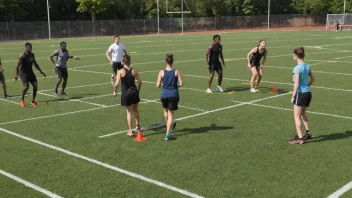Training as a runner can often feel overwhelming. With countless methods and strategies available, how does one determine the best approach to improve performance and achieve personal goals? Goal-oriented training provides a clear path for runners to follow, allowing them to focus their efforts and maximize their potential. This article will delve into the significance of goal-oriented training, outlining its benefits, various techniques, and how to set achievable goals that lead to improved running performance.
Understanding Goal-Oriented Training
Goal-oriented training is a structured approach that focuses on specific objectives to enhance performance. Unlike a general training regimen, goal-oriented training provides clarity and direction. By establishing clear, measurable, and attainable goals, runners can monitor their progress and make necessary adjustments to their training plans.
The Benefits of Goal-Oriented Training
- Improved Focus: When runners have a clear goal in mind, they can concentrate their training efforts more effectively, which leads to better results.
- Enhanced Motivation: Achieving small milestones along the way to a larger goal can boost motivation and keep runners engaged in their training.
- Structured Progression: Goal-oriented training encourages a systematic approach to training, allowing runners to gradually increase intensity and volume.
- Injury Prevention: By focusing on specific goals, runners can tailor their training to avoid overtraining and reduce the risk of injury.
Types of Goals for Runners
Setting goals is an essential part of the goal-oriented training process. Goals can generally be categorized into three types: performance goals, process goals, and outcome goals.
Performance Goals
Performance goals focus on measurable aspects of running, such as achieving a specific time in a race or improving pace over a set distance. For example, a runner might aim to complete a 5K in under 25 minutes. These goals are quantifiable and allow runners to track their progress over time.
Process Goals
Process goals emphasize the actions and behaviors required to achieve performance goals. These might include committing to a certain number of training sessions per week, incorporating strength training, or focusing on proper running form. By concentrating on the process, runners can make meaningful changes that contribute to their overall performance.
Outcome Goals
Outcome goals are broader objectives, such as finishing a marathon or qualifying for a prestigious race. While these goals can be motivating, they often depend on factors outside a runner's control, such as competition and weather conditions. Therefore, it’s essential to balance outcome goals with performance and process goals for a well-rounded training approach.
Setting SMART Goals
To maximize the effectiveness of goal setting, runners should consider the SMART criteria: Specific, Measurable, Achievable, Relevant, and Time-bound. This framework helps ensure that goals are well-defined and attainable.
Specific
Goals should be clear and specific. Instead of saying, “I want to run faster,” a more specific goal would be, “I want to improve my 10K time by five minutes.”
Measurable
Goals must be measurable to track progress. Incorporating time, distance, or frequency makes it easier to evaluate performance.
Achievable
While it’s important to challenge oneself, goals should also be realistic. Setting an unachievable goal can lead to frustration and decreased motivation.
Relevant
Goals should align with a runner's personal motivations and overall objectives. For instance, a runner aiming to compete in ultramarathons might focus on endurance training rather than speed.
Time-bound
Setting a deadline creates urgency and encourages commitment. For example, “I want to run a sub-4-hour marathon in six months” provides a clear timeframe.
Training Strategies for Goal-Oriented Running
Once goals are established, runners can implement various strategies to achieve them. Here are some effective training strategies:
Interval Training
Interval training involves alternating periods of high-intensity running with periods of rest or low-intensity running. This method can significantly improve speed and endurance, making it an excellent strategy for achieving performance goals.
Long Runs
Incorporating long runs into the training schedule builds endurance and prepares runners for longer distances. Gradually increasing the distance of long runs is essential for successful training.
Cross-Training
Engaging in cross-training activities such as cycling, swimming, or strength training helps improve overall fitness and reduces the risk of injury due to repetitive strain on running muscles.
Rest and Recovery
Rest days are crucial in any training program. Allowing the body to recover helps prevent injury and promotes muscle growth, leading to better performance.
Monitoring Progress and Adjusting Goals
Regularly assessing progress is vital for any goal-oriented training plan. Runners should keep detailed training logs to track performance, monitor improvements, and identify areas for adjustment. If a goal seems too ambitious or unattainable, it’s crucial to reassess and modify it accordingly.
Conclusion
Goal-oriented training is a powerful approach for runners seeking to enhance their performance while prioritizing safety and injury prevention. By setting specific, measurable, achievable, relevant, and time-bound goals, runners can create a structured training plan that keeps them motivated and focused. Implementing effective training strategies such as interval training, long runs, and cross-training will further support their journey toward achieving their running aspirations. With consistent monitoring and adjustments, runners can remain on track and make continual progress, ultimately leading to greater enjoyment and success in their running endeavors.






